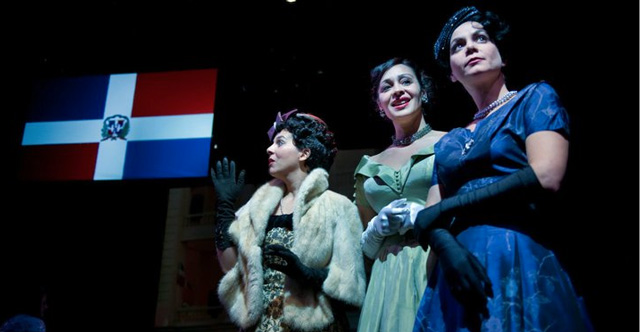(Michael Palma)
By Jennifer Regalado
On November 25th 1960, Rafael Trujillo, the president of the Dominican Republic, ordered the murder of three of the four Mirabal sisters. On that day, Patria, Minerva, and Maria Teresa Mirabal lost their lives. Dede Mirabal, the second oldest of the Mirabal sisters, was spared. Dede supported her sisters’ activism against Trujillo, who ruled the island nation with an iron fist for 30 years. But, unlike her sisters, Dede decided never to act out against his cruel dictatorship.
The Repertorio Español theater, located on 138 East 27th Street, is presenting the play En El Tiempo De Las Mariposas, based on the Mirabal sisters, their lives and their fight against Trujillo’s tyranny. The play entertaining and also informative, as it offers the audience insights into events occurring during that time in history. The play takes place from 1938, when the sisters were young, to 1960, when they were murdered.
The cast is six women and one man. Patria is played by Rosie Berrido, young Dede by Zulema Clares, older Dede by Teresa Perez Frangie, Minerva by Malena Ramirez, Maria Teresa by Luisa Ines Garcia Del Castillo, and an American writer is performed by Nahoalli Nassourou. Fermin Suarez plays the role of four people, a DJ, Virgilio Morales (a friend to the Mirabal sisters and anti-Trujillo), Trujillo, and Rufino De La Cruz (killed alongside the Mirabal sisters).
The stage has only one set, a garden with big screen projectors, which project butterflies, flowers, scenes from the countryside, and the years in which each scene takes place in. Some people might think that only one set on the stage would diminish the play, but I believe that it doesn’t hurt it at all. The actors held my attention so well, that the lack of variety on the set didn’t matter.
Of the Mirabal sisters, Dede is the only one to have two people play her younger and older selves. I believe this is a positive attribute of the play. Dede is the only sister still living. Having two people play her three deceased sisters would not have made sense. When each of the sisters act a scene on stage, they state the date and year, the projectors show it, or the narrator, in the form of a DJ, says it as well.
The way that the actors are dressed also gives an approximation of the year, how old they are and which character they are playing. When the play begins, the sisters are wearing dresses for young girls. As they age, so do their outfits. When Ramirez and Castillo act out a scene in jail, they wear jail uniforms, in the forms of dresses and gowns. The American writer looks up-to-date, wearing a t-shirt and jeans. Lastly, Suarez wears regular short sleeve dress shirts and slacks when he plays the characters of the DJ, Virgilio Morales, and Rufino De La Cruz. When he plays the role of Trujillo, he wears an old-style general uniform.
All the actors deliver a marvelous performance, but I have to say that Berrido delivers a particularly outstanding one, with her Patria role. She plays a cautious and careful woman. During her solo scenes, I felt for her. Suarez is also amazing because he is able to play the role of four men, and deliver each of them perfectly, never confusing the audience about who he is playing at the time.
The play runs through this month. With a student I.D., there is a $5 discount. If you want to learn more about three of the most important figures in the history of the Dominican Republic, I recommend this play.










No comments